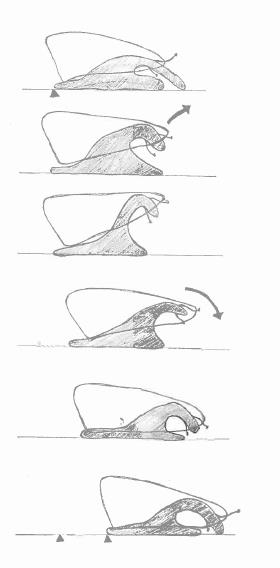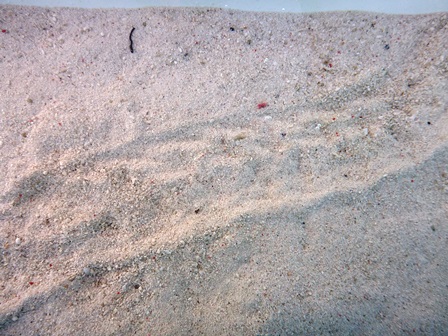Locomotion
Locomotion in Strombus and Lambis can best be described as "leaps”. In all the literature the movement of strombids is distinguished as jerky and discontinuous leaping motions, as opposed to the continuous and smooth sliding motion of common gastropods (Berg 1975, 1974; Perron 1978; Savazzi 1991). There are two distinctive behaviour patterns that have been described for the leap: (1) The shell is thrown forward by thrusting the foot and operculum backwards; and (2) The foot extends forward and a sharp muscular contraction pulls the shell forward shell. The choice between the locomotory style of the strombid may be related to the type of substrate across which it is moving (Berg 1974). Observations on strombids with flared wings, such as L. lentiginosus, show that the location of the centre of gravity during locomotion has a dramatic effect. This issue is more pronounced in juveniles, immatures and subadults which have more unbalanced locomotion, and can have a tendency to overturn when landing after a leap (Savazzi 1991). Possibly as a result of this, locomotion in juveniles tends to be via rhythmical crawling, with `leaping' only taking place as an escape response from predators (Perron 1978). In contrast, the adult snails ‘leap’ during both normal and escape locomotion.
Video of the leaping locomotry style of Lentigo lentiginosus (Source: Asia Armstrong).
The escape response in both Strombus and Lambis species consists of two components: (1) an increase in the rate of locomotion; and (2) change of direction of locomotion away from the predator (Kohn & Waters 1966). During the leaping motion, the soft bodied parts of the animal remain under the protection of the shell and over short periods of time the rate of locomotion increases to that of a sprint (Berg 1975). Overall the locomotion mode of Strombus species does not result in a higher rate of progress away from a predator than that of other marine gastropods that use locomotry waves to slide over substrate (Kohn & Waters 1966). This is due to the lag or recovery period between leaps. However, the leaping mode of locomotion does infer an advantage by increasing the distance from the danger almost instantaneously in a single leap (Kohn & Waters 1966).

Figure 1. Diagram of the leaping motion of Lentigo lentiginosus. The arrow under the first frame of the image displays the starting location of the animal and on the final frame the distance moved after one leap, on average 1cm (adapted from Berg, 1974).
L. lentiginosus uses a combination of similar movements as that of closely related Strombus species such as S. maculatus, S. gibberulus and S. luhuanus. It is the largest species of Strombus and covers the greatest distance per leap with respect to other species (1.8 cm/leap = 27% of shell length/leap) (Berg 1974).

Image of the trail left through fine sediment after an individual Lentigo lentiginosis has moved across the substrate using its leaping mode of locomotion (Photographer: Asia Armstrong). |